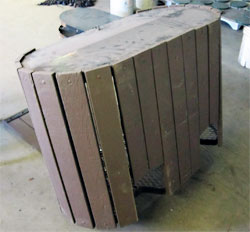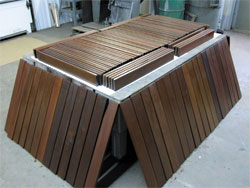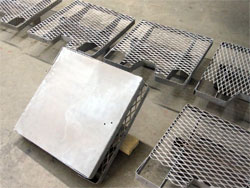|
Rebuilding cooler stands...
Jeff Johnson, The Minikahda Club, Minneapolis, MN:
 
"This winter we decided it was time to rebuild our cooler stands. We've estimated the original stands were built over 25 years ago when Dan Hanson was the Superintendent. The wood slates have been replaced numerous times. The last time the wood was replaced was about 10 years ago. At that time we utilized cedar. The wood has held up well over the years. Annually the wood has been stained and the metal has always received a fresh coat of paint but the time has come to upgrade the quality and appearance.
This time we felt it was important to replace the wood with the identical wood that is used for the benches and tee markers. Our goal is to maintain a consistency with the products we use on the course and create a clean well maintained look, not only to the playing surfaces, but to the course accessories as well.
If we were to purchase the cooler stands that are made with the same wood type, costs would exceed $850 per stand. With nine stands needing new wood our costs would exceed $7600. We were able to purchase the identical wood for only $1500. Of course we will have a good number of our own man-hours into the project, but there is a certain amount of satisfaction that comes from doing the work in house.
 Freshly stained wood
Freshly stained wood
|
 Metal bases had years of paint stripped and sandblasted off. Primer has been applied and now await a fresh coat of black paint.
Metal bases had years of paint stripped and sandblasted off. Primer has been applied and now await a fresh coat of black paint.
|
Assembly of the the nine stands will take some time but when completed will have all new hardware and will be as good if not better than ones purchased from a supplier."
Visit Jeff's blog at minikahdagrounds.blogspot.com.
|